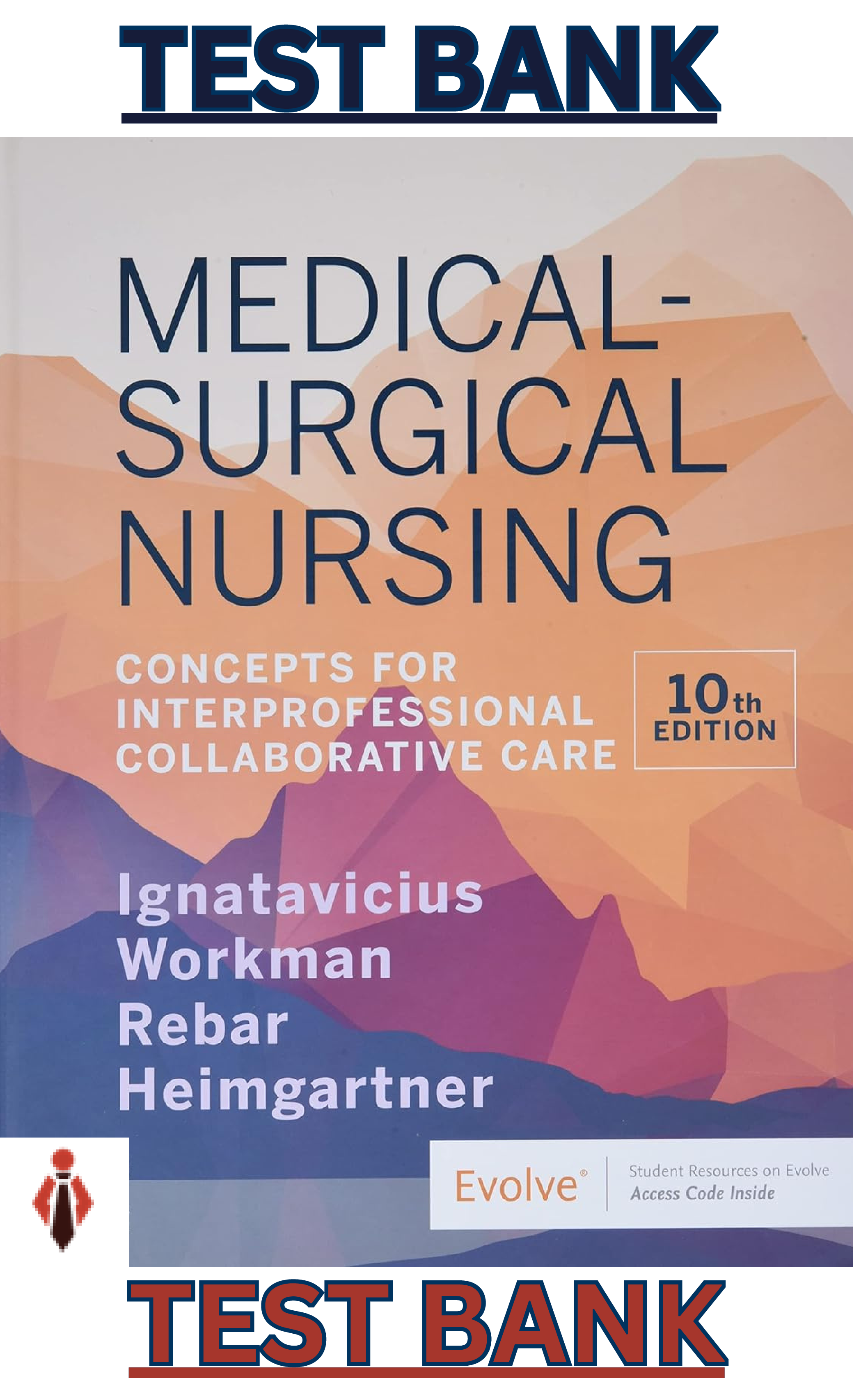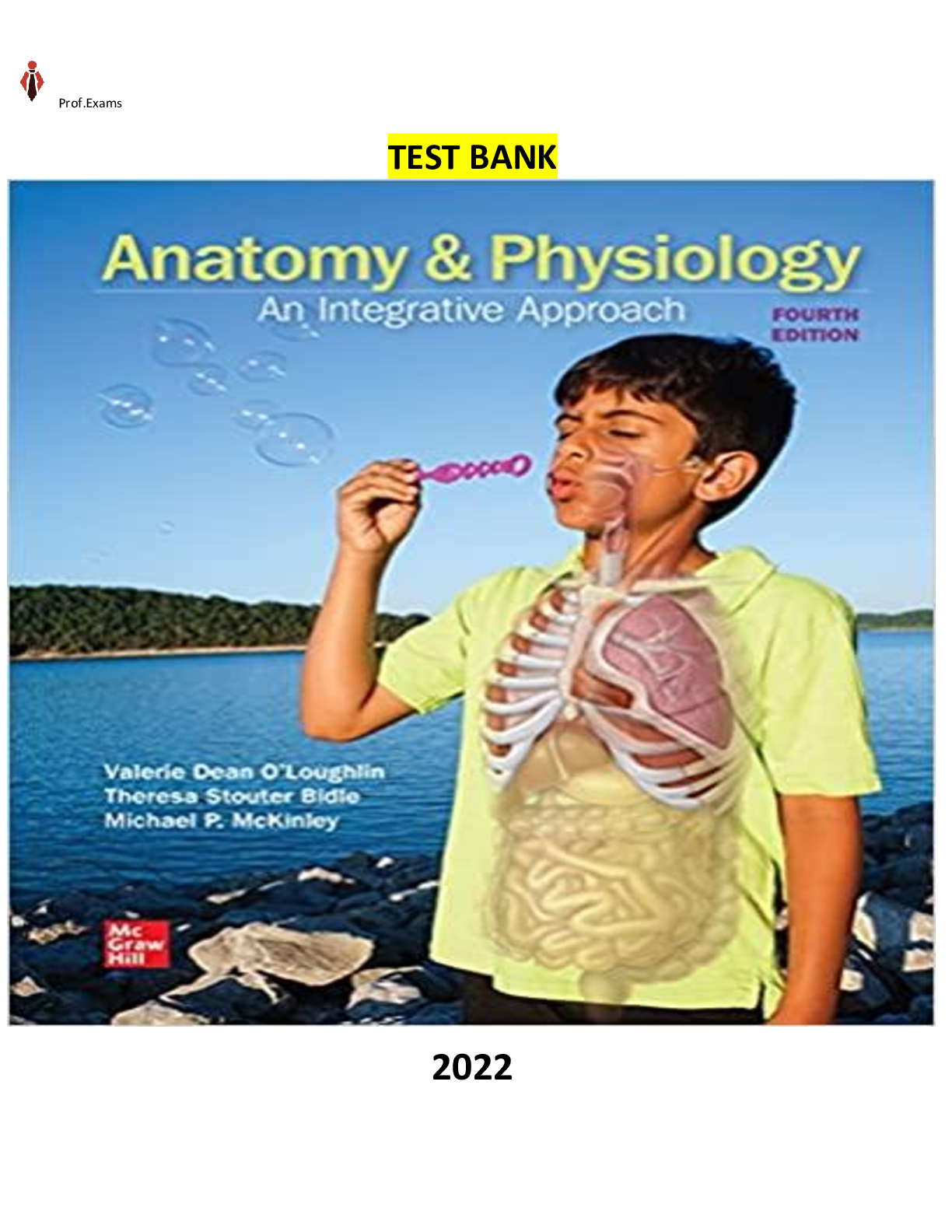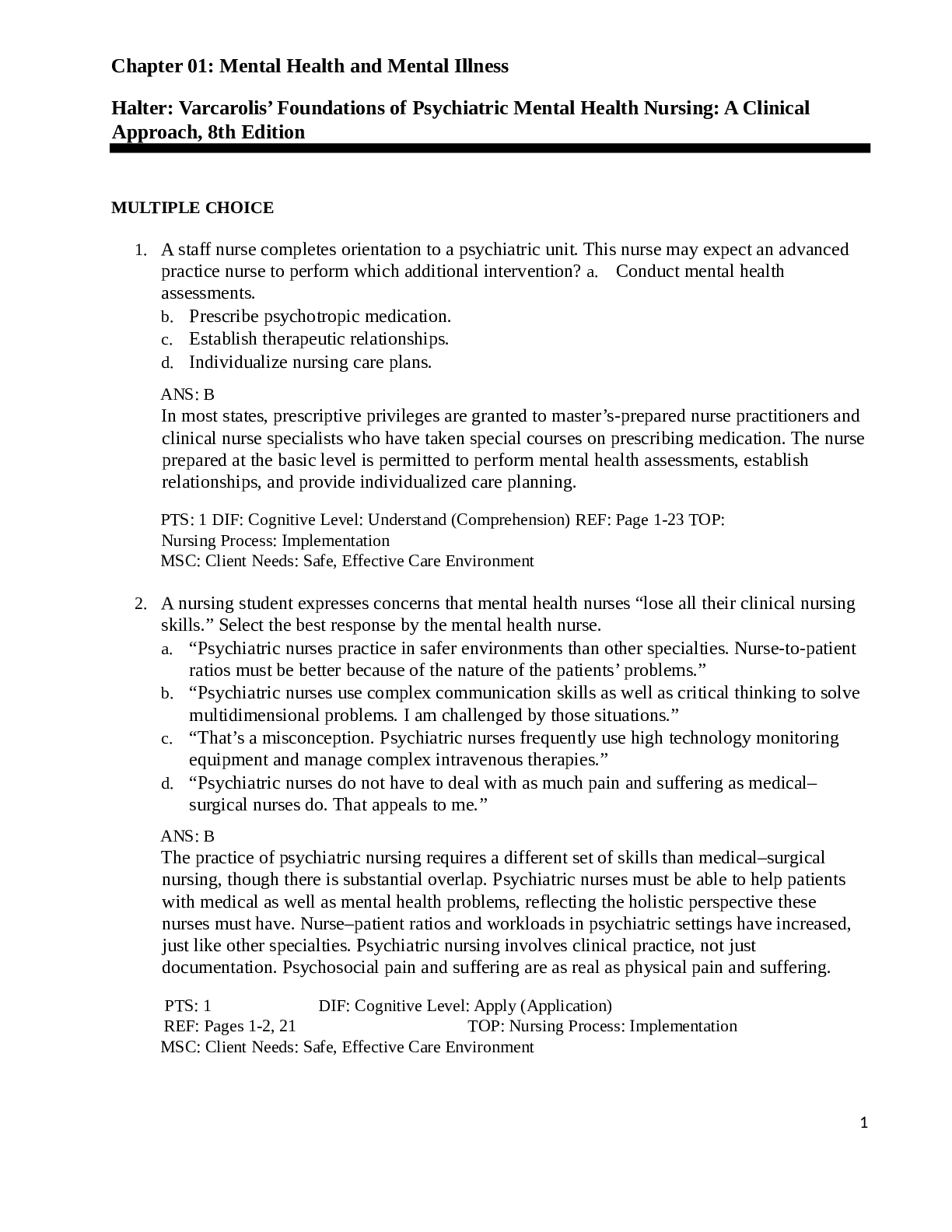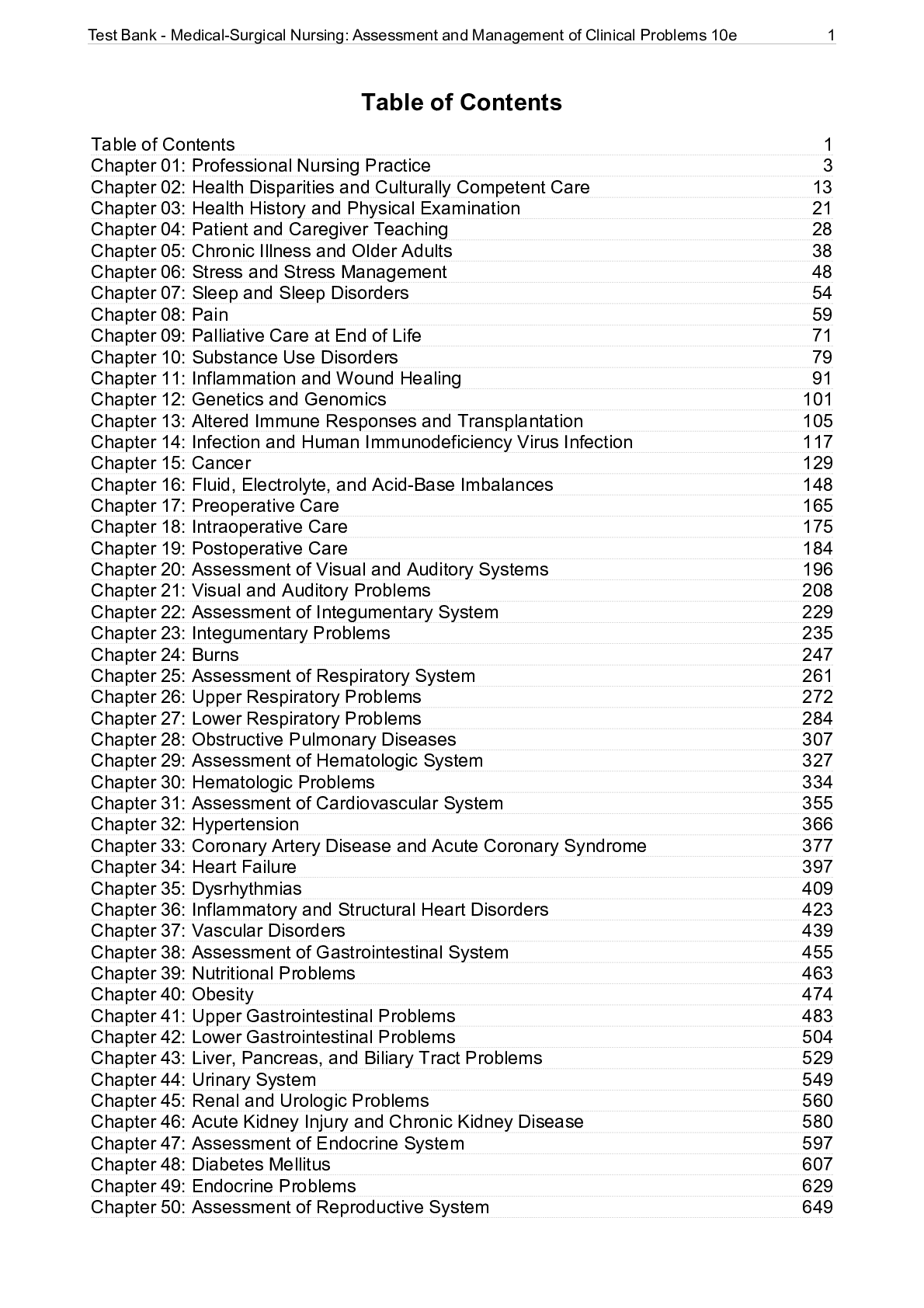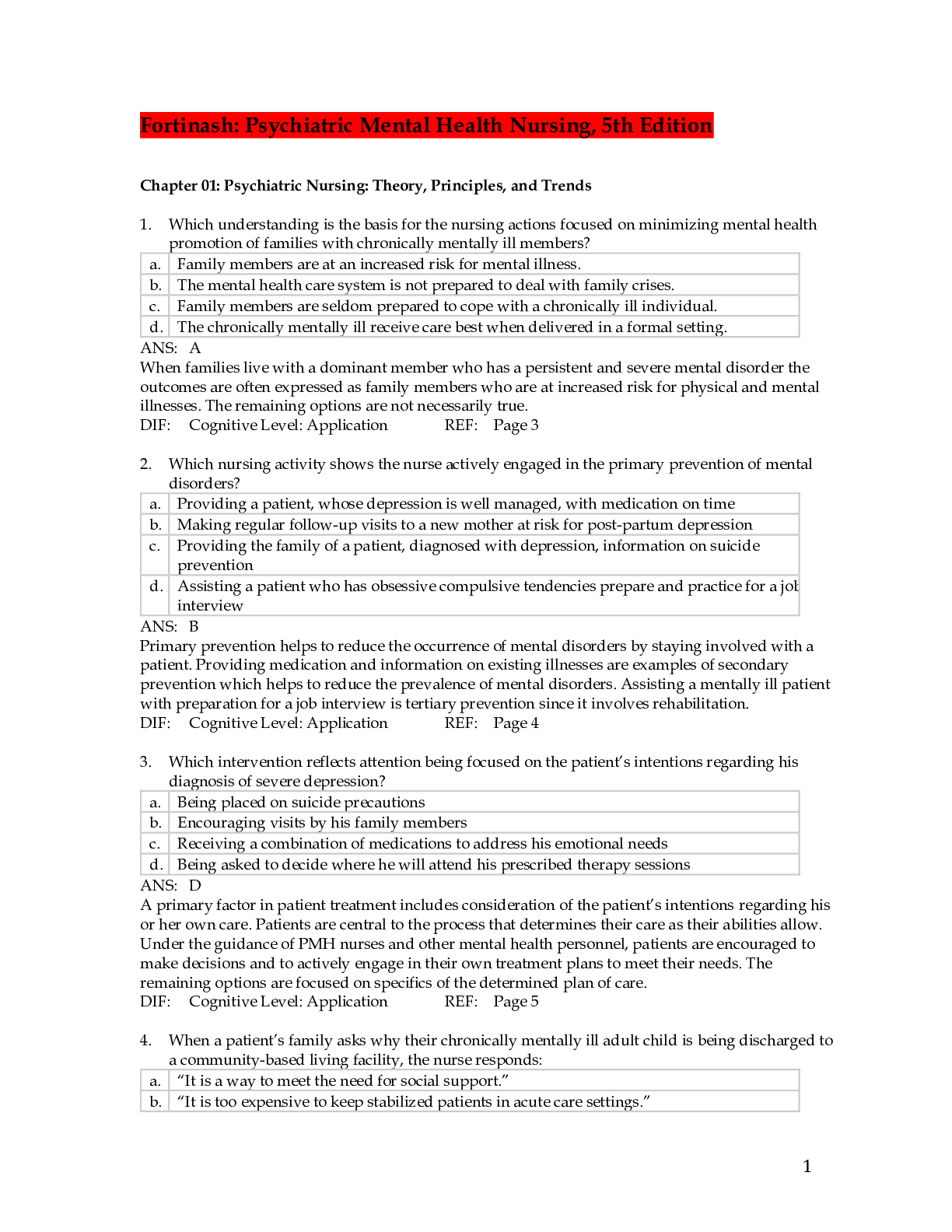Psychiatry > TEST BANKS > Test bank for Davis Advantage for Townsend's Psychiatric Mental Health Nursing 10Ed by Karyn I. Morg (All)
Test bank for Davis Advantage for Townsend's Psychiatric Mental Health Nursing 10Ed by Karyn I. Morgan. ALL Chapters(1-37)
Document Content and Description Below
COMPLETE - Elaborated Test bank for Davis Advantage for Townsend's Psychiatric Mental Health Nursing 11Ed.by Karyn I. Morgan. ALL Chapters(1-37) Included |464| Pages - Questions & Answers Pass Basic ... Psychiatric Mental Health Nursing in First Attempt Guaranteed!Get 100% Latest Exam Questions, Accurate & Verified Answers to Pass the Actual Exam! Instant Download! COMPLETE - Elaborated Test bank for Davis Advantage for Townsend's Psychiatric Mental Health Nursing 11Ed.by Karyn I. Morgan. ALL Chapters(1-37) Included |464| Pages - Questions & Answers Pass Basic Psychiatric Mental Health Nursing in First Attempt Guaranteed!Get 100% Latest Exam Questions, Accurate & Verified Answers to Pass the Actual Exam! Instant Download! Davis Advantage for Townsend's Psychiatric Mental Health Nursing 11Ed.by Karyn I. Morgan ISBN-10 1719648247 ISBN-13 978-1719648240 I. BASIC CONCEPTS IN PSYCHIATRIC-MENTAL HEALTH NURSING 1. The Concept of Stress Adaptation 2. Mental Health and Mental Illness: Historical and Theoretical Concepts II. FOUNDATIONS FOR PSYCHIATRIC-MENTAL HEALTH NURSING 3. Concepts of Psychobiology 4. Psychopharmacology 5. Ethical and Legal Issues III. THERAPEUTIC APPROACHES IN PSYCHIATRIC NURSING CARE 6. Relationship Development 7. Therapeutic Communication 8. The Nursing Process in Psychiatric-Mental Health Nursing 9. Therapeutic Groups 10. Intervention with Families 11. Milieu Therapy—The Therapeutic Community 12. Crisis Intervention 13. Assertiveness Training 14. Promoting Self Esteem 15. Anger and Aggression Management 16. Suicide Prevention 17. Behavior Therapy 18. Cognitive Behavioral Therapy 19. Electroconvulsive Therapy 20. The Recovery Model IV. NURSING CARE OF PATIENTS WITH ALTERATIONS IN PSYCHOSOCIAL ADAPTATION 21. Caring for Patients with Mental Illness and Substance Use Disorders in General Practice Settings 22. Neurocognitive Disorders 23. Substance-Related and Addictive Disorders 24. Schizophrenia Spectrum and Other Psychotic Disorders 25. Depressive Disorders 26. Bipolar and Related Disorders 27. Anxiety, Obsessive-Compulsive, and Related Disorders 28. Trauma and Stressor-Related Disorders 29. Somatic Symptom and Dissociative Disorders 30. Eating Disorders 31. Personality Disorders V. PSYCHIATRIC/MENTAL HEALTH NURSING OF SPECIAL POPULATIONS 32. Children and Adolescents 33. The Aging Individual 34. Survivors of Abuse or Neglect 35. Community Mental Health Nursing 36. The Bereaved Individual 37. Military Families 1. For several years, the nurse has been working in the subspecialty field of forensic nursing. In this field, the nurse would recognize which current trend? 1. A decrease in violent crime has resulted in a decreased need for forensic nurses. 2. Medical examiners prefer to employ forensic nurses because of their medical background. 3. With increasing numbers of violent crimes, forensic nurses are in greater demand than ever. 4. Forensic nurses comprise a dwindling subspecialty. ANS: 3 Chapter: Chapter 43, Forensic Nursing Objective: Discuss historical perspectives of forensic nursing. Page: 966 Heading: Historical Perspectives Integrated Processes: Nursing Process Nursing Process: Assessment Client Need: Psychosocial Integrity Cognitive Level: Knowledge [Remembering] Concept: Health Care System Difficulty: Moderate Feedback 1. This is incorrect. Violent crime has increased, and there is an increased need for forensic nurses. 2. This is incorrect. Forensic nurses are nurses with additional training in forensics; they did not go to medical school. 3. This is correct. Violent crime has reached epidemic proportions in the United States and is identified as a major public health problem, increasing the demand for forensic nurses. 4. This is incorrect. Forensic nurses are in high demand but do not comprise a dwindling subspecialty. CON: Health Care System 2. An 18-year-old client is admitted to an emergency department, reporting that she has just been raped. On physical assessment, the nurse notices no trauma to the genital region. Which information would influence the forensic nurse’s evaluation of this assessment data? 1. Between 60% and 80% of confirmed rapes show genital trauma. 2. Inconsistency of verbalized reports and collected evidence suggests deception. 3. Lack of genital trauma indicates consensual sex. 4. Between 40% and 60% of sexual assaults leave no visible injuries. ANS: 4 Chapter: Chapter 43, Forensic Nursing Objective: Apply the nursing process within the role of clinical forensic nursing in trauma care. Page: 968 Heading: Application of the Nursing Process in Clinical Forensic Nursing Trauma Care > Planning/Implementation > Treatment and Documentation of Injuries Integrated Processes: Nursing Process Nursing Process: Assessment Client Need: Physiological Integrity: Physiological Adaptation Cognitive Level: Knowledge [Remembering] Concept: Violence Difficulty: Moderate Feedback 1. This is incorrect. Between 40% and 60% of sexual assaults showed no visible injuries. 2. This is incorrect. Inconsistency between verbalized reports and collected evidence does not necessarily mean an assault did not occur. 3. This is incorrect. The absence of physical trauma (either genital or nongenital) does not necessarily mean that no force was used or that consent was given. 4. This is correct. There may be no visible injuries in 40% to 60% of sexual assaults. CON: Violence 3. A forensic nurse collects a semen sample from a rape victim. Which nursing action maintains the proper chain of evidence? 1. A collected sample is labeled, sealed, and kept in a locked refrigerator until given to police. 2. The sample is locked in a special container and given to the pathologist. 3. The sample is placed in the medication room refrigerator prior to police collection. 4. The sample is sealed and immediately given to police to avoid contamination. ANS: 1 Chapter: Chapter 43, Forensic Nursing Objective: Apply the nursing process within the role of clinical forensic nursing in trauma care. Page: 968 Heading: Application of the Nursing Process in Clinical Forensic Nursing Trauma Care > Planning/Implementation > Preservation of Evidence > Maintaining the Proper Chain of Custody Integrated Processes: Nursing Process Nursing Process: Implementation Client Need: Safe and Effective Care Environment: Management of Care Cognitive Level: Application [Applying] Concept: Legal Difficulty: Moderate Feedback 1. This is correct. Collected evidence must be kept separate from other items, labeled, and sealed to prevent tampering or loss. Sealed and correctly labeled evidence kits or bags may be stored in a secure location until they are transferred to law enforcement officials. The best place to store evidence is in a locked drop box and locked refrigerator, located in a limited-access room that requires key entry. 2. This is incorrect. The sample is given to the police, not the pathologist. 3. This is incorrect. The medication room is not the room with the most limited access. 4. This is incorrect. Sealed and correctly labeled evidence kits or bags may be stored in a secure location until they are transferred to law enforcement officials. CON: Legal 4. A rape victim is concerned about becoming pregnant. Which intervention by the nurse practitioner is appropriate? 1. Refer the client to an abortion clinic. 2. Refer the client to a spiritual counselor. 3. Offer the client Plan B One-Step. 4. Instruct the client to douche daily for 1 week. ANS: 3 Chapter: Chapter 43, Forensic Nursing Objective: Apply the nursing process within the role of clinical forensic nursing in trauma care. Page: 968 Heading: Application of the Nursing Process in Clinical Forensic Nursing Trauma Care > Planning/Implementation > Pregnancy Risk Evaluation and Prevention Integrated Processes: Nursing Process Nursing Process: Implementation Client Need: Physiological Integrity: Pharmacological and Parenteral Therapies Cognitive Level: Analysis [Analyzing] Concept: Violence Difficulty: Moderate Feedback 1. This is incorrect. There is no indication the client is pregnant; in addition, it is not appropriate for the provider to refer the client to an abortion clinic. 2. This is incorrect. If the client is concerned about becoming pregnant, referring her to a spiritual advisor does not address her concerns. 3. This is correct. Sexual assault victims should receive information related to risks and interventions for prevention of conception resulting from the assault. Prophylactic measures, like the use of Plan B One-Step, are 97% to 98% effective in preventing pregnancy if given in the first 24 hours after a sexual attack. Evaluation of pregnancy risk is based on the client’s ability to relay accurate information about the occurrence of her last menses so that an estimate can be made of time of ovulation. 4. This is incorrect. Douching daily for 1 week will not prevent pregnancy. CON: Violence 5. Which statement indicates the most important reason for the forensic nurse to maintain a proper chain of evidence? 1. Maintaining a proper chain of evidence will exonerate the perpetrator. 2. Maintaining a proper chain of evidence will assist in gathering enough data for conviction. 3. All evidence, if properly maintained, will convict the assailant. 4. Crime data maintained with a proper chain of evidence can be used in a court of law. ANS: 4 Chapter: Chapter 43, Forensic Nursing Objective: Apply the nursing process within the role of clinical forensic nursing in trauma care. Page: 969 Heading: Application of the Nursing Process in Clinical Forensic Nursing Trauma Care > Planning/Implementation > Preservation of Evidence > Maintaining the Proper Chain of Custody Integrated Processes: Nursing Process Nursing Process: Assessment Client Need: Safe and Effective Care Environment: Management of Care Cognitive Level: Analysis [Analyzing] Concept: Legal Difficulty: Moderate Feedback 1. This is incorrect. Maintaining a chain of evidence does not exonerate the perpetrator. 2. This is incorrect. Maintaining a proper chain of evidence does not assist in gathering enough data for conviction. 3. This is incorrect. Just because evidence is properly maintained does not necessarily mean the assailant will be convicted. 4. This is correct. Chain of custody is a legal process referring to the paper trail that assures the integrity and security of the evidence. Unless the proper chain of custody has been maintained, evidence cannot be used successfully in a court of law to convict an assailant. CON: Legal 6. A sexual assault nurse examiner is called to examine a college student who reports a date rape. Which nursing intervention is the priority? 1. Take samples of potential evidence. 2. Ensure medical stabilization. 3. Take pictures of the wounds. 4. Call law enforcement officials to report the rape. ANS: 2 Chapter: Chapter 43, Forensic Nursing Objective: Apply the nursing process within the role of clinical forensic nursing in trauma care. Page: 969 Heading: Application of the Nursing Process in Clinical Forensic Trauma Care > Planning/Implementation > Preservation of Evidence Integrated Processes: Nursing Process Nursing Process: Implementation Client Need: Physiological Integrity: Physiological Adaptation Cognitive Level: Application [Applying] Concept: Violence Difficulty: Moderate Feedback 1. This is incorrect. Although taking samples of evidence is a nursing intervention that will be implemented, ensuring medical stabilization is the priority. 2. This is correct. When a sexual assault victim is admitted to the emergency department, medical stabilization is the priority intervention. 3. This is incorrect. Taking pictures of the wounds will occur after the client is medically stable. 4. This is incorrect. The nurse will call law enforcement to report the rape after the client is medically stable. CON: Violence 7. Which inmate statement to the prison nurse describes the circumstances that have the strongest correlation with recidivism among the prison population? 1. “I was high on crack when I blew him away.” 2. “I never finished high school.” 3. “My upbringing was nonexistent.” 4. “I’m a product of the foster care system.” ANS: 1 Chapter: Chapter 43, Forensic Nursing Objective: Apply the nursing process within the role of clinical forensic nursing in trauma care. Page: 973 Heading: Assessing Mental Health Needs of the Incarcerated Integrated Processes: Nursing Process Nursing Process: Assessment Client Need: Physiological Integrity Cognitive Level: Evaluation [Evaluating] Concept: Addictions and Behaviors Difficulty: Moderate Feedback 1. This is correct. Substance abuse has been shown to have a strong correlation with recidivism among the prison population. Many individuals report that they were under the influence of illegal substances at the time of their criminal actions. 2. This is incorrect. Not completing high school does not mean a client will reoffend. 3. This is incorrect. A poor upbringing is not an indicator of recidivism. 4. This is incorrect. Being a product of the foster care system does not necessarily mean the client will reoffend. CON: Addiction and Behaviors 8. A prison nurse is reviewing an inmate’s health record. Which documentation indicates a dual diagnosis? 1. Bipolar II disorder and antisocial personality disorder 2. Schizophrenia and alcohol dependence 3. Attention deficit disorder and conduct disorder 4. Cocaine addiction and marijuana abuse ANS: 2 Chapter: Chapter 43, Forensic Nursing Objective: Apply the nursing process within the role of clinical forensic nursing in trauma care. Page: 973 Heading: Assessing Mental Health Needs of the Incarcerated Integrated Processes: Communication and Documentation Client Need: Psychosocial Integrity Cognitive Level: Analysis [Analyzing] Concept: Addiction and Behaviors Difficulty: Moderate Feedback 1. This is incorrect. Bipolar disorder and antisocial personality disorder are not dual diagnoses. 2. This is correct. An individual who has a coexisting substance disorder and a mental illness meets the criteria for dual diagnoses. Dual diagnoses are commonly identified in incarcerated individuals. Psychiatric diagnoses commonly identified in incarcerated individuals include schizophrenia, bipolar disorder, major depression, substance use disorders, and personality disorders. 3. This is incorrect. Attention deficit disorder and conduct disorder are not dual diagnoses. 4. This is incorrect. Cocaine addiction and marijuana abuse are not dual diagnoses. CON: Addiction and Behaviors 9. In a gang war, a gang member is wounded. The police have confiscated a switchblade. When assessing the victim, which type of injury would the forensic nurse expect to assess? 1. Dicing injuries 2. Sharp-force injuries 3. Patterned injuries 4. Defense wound injuries ANS: 2 Chapter: Chapter 43, Forensic Nursing Objective: Apply the nursing process within the role of clinical forensic nursing in trauma care. Page: 969 Heading: Application of the Nursing Process in Clinical Forensic Nursing in the Investigation of Trauma Care > Investigation of Wound Characteristics Integrated Processes: Assessment Nursing Process: Assessment Client Need: Physiological Integrity: Physiological Adaptation Cognitive Level: Analysis [Analyzing] Concept: Violence Difficulty: Moderate Feedback 1. This is incorrect. Dicing injuries are multiple, minute cuts and abrasions caused by contact with shattered glass that often occur in motor vehicle accidents. 2. This is correct. Sharp-force injuries include stab wounds and other wounds resulting from penetration with a sharp object, such as a switchblade. 3. This is incorrect. Patterned injuries are specific injuries that reflect the pattern of the weapon used to inflict the injury. 4. This is incorrect. Defense wounds are injuries that reflect the victim’s attempt to defend themself from attack. CON: Violence 10. A forensic nurse identified patterned injuries on a 3-year-old child. Which assessment data led to this conclusion? 1. Multiple minute cuts and abrasions 2. Generalized bruising of the buttock 3. Circular burn marks the size of a lit cigarette 4. Stab wounds resulting from sharp-object penetration ANS: 3 Chapter: Chapter 43, Forensic Nursing Objective: Apply the nursing process within the role of clinical forensic nursing in trauma care. Page: 969 Heading: Application of the Nursing Process in Clinical Forensic Nursing in the Investigation of Trauma Care > Investigation of Wound Characteristics Integrated Processes: Nursing Process Nursing Process: Assessment Client Need: Physiological Integrity: Physiological Adaptation Cognitive Level: Analysis [Analyzing] Concept: Violence Difficulty: Moderate . [Show More]
Last updated: 7 months ago
Preview 1 out of 942 pages
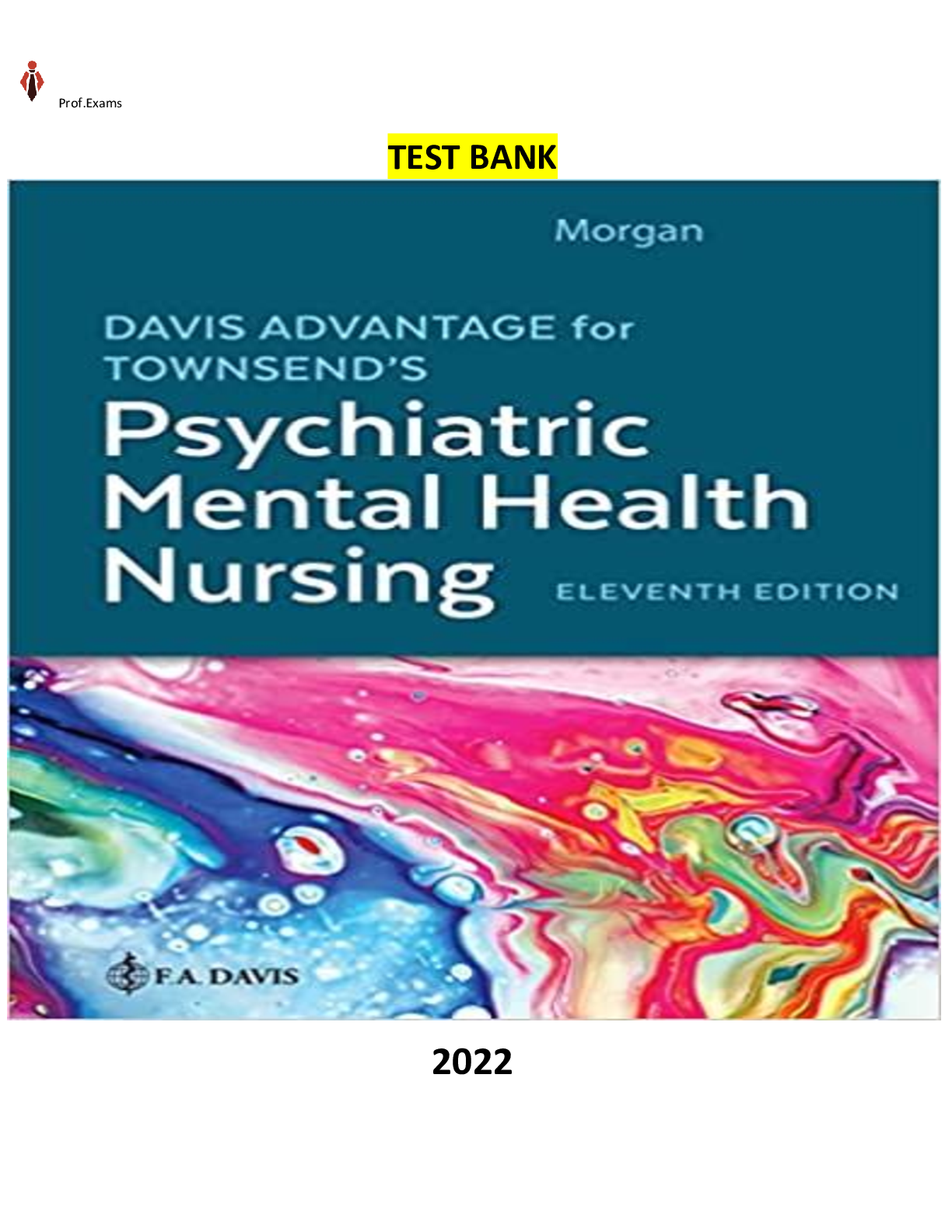
Buy this document to get the full access instantly
Instant Download Access after purchase
Buy NowInstant download
We Accept:

Reviews( 0 )
$27.50
Can't find what you want? Try our AI powered Search
Document information
Connected school, study & course
About the document
Uploaded On
May 26, 2023
Number of pages
942
Written in
Additional information
This document has been written for:
Uploaded
May 26, 2023
Downloads
0
Views
170


